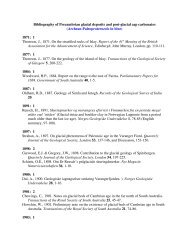A Neoproterozoic Rock Sample Suite - Snowball Earth
A Neoproterozoic Rock Sample Suite - Snowball Earth
A Neoproterozoic Rock Sample Suite - Snowball Earth
You also want an ePaper? Increase the reach of your titles
YUMPU automatically turns print PDFs into web optimized ePapers that Google loves.
Namibia TS-1<br />
Kielberg Member of the Maiberg ‘cap’ carbonate succession<br />
What are Cap Carbonates<br />
(Taken from www.<strong>Snowball</strong><strong>Earth</strong>.org)<br />
1 cm<br />
Carbonate laminite bounding the Ghaub glacial units<br />
Namibia TS-1 is a thinly bedded to laminated allodapic (turbidite)<br />
dolostone that lies in sharp contact with the upper member of the Ghaub.<br />
formation. Namibia TS-1 directly overlies the Ghaub glacial deposits. The<br />
sharpness of the contact of the upper member of the Ghaub with the<br />
Kielberg cap carbonate implies a rapid transition between glacial and<br />
marine deposition. There is limited evidence for seasonal cyclicity in the<br />
Kielberg member, although it's interpretation as being a rhythmite has<br />
not been ruled out.<br />
Cap carbonates are continuous layers of limestone<br />
(CaCO3) and/or dolostone (Ca0.55Mg0.45CO3)<br />
that sharply overlie <strong>Neoproterozoic</strong> glacial deposits, or<br />
sub-glacial erosion surfaces where the glacial deposits<br />
are absent. They are typically 3-30 m thick and occur<br />
on platforms, shelves and slopes world-wide, even in<br />
regions otherwise lacking carbonate strata. Sturtian<br />
(~700 Ma) and Marinoan (635 Ma) cap carbonates are<br />
lithologically distinct, and both have unusual traits (e.g.,<br />
thick sea-floor cements, giant wave ripples, microbial<br />
mounds with vertical tubular structure, primary and<br />
early diagenetic barite, BaSO4) that distinguish them<br />
from standard carbonates. Marinoan cap carbonates<br />
are transgressive (i.e., inferred water depths increase<br />
with stratigraphic height) and most workers associate<br />
them with the flooding of continental shelves and<br />
platforms as ice sheets melted. Most Sturtian cap<br />
carbonates were not deposited until after post-glacial<br />
flooding had taken place. The preservation of cap<br />
carbonates and related highstand deposits after<br />
isostatic adjustment (or post-glacial “rebound”) implies<br />
substantial erosion and/or tectonic subsidence during<br />
the glacial period. Post-Marinoan (Ediacaran and Phanerozoic)<br />
glaciations lack cap carbonates, or they are<br />
poorly developed.<br />
<strong>Sample</strong> TS-1 In the Field<br />
3 4



